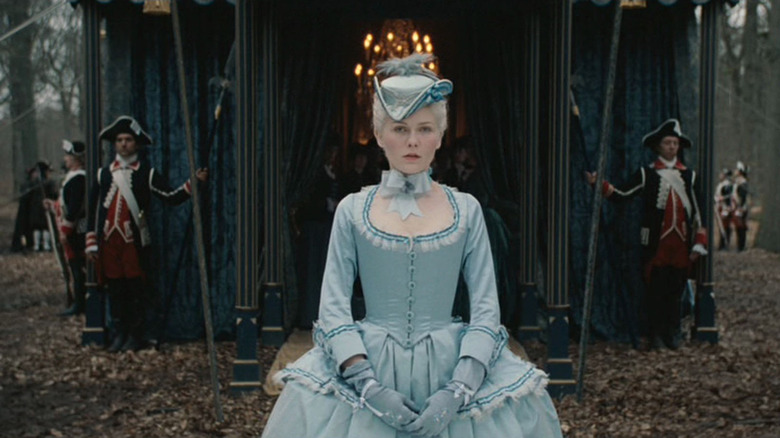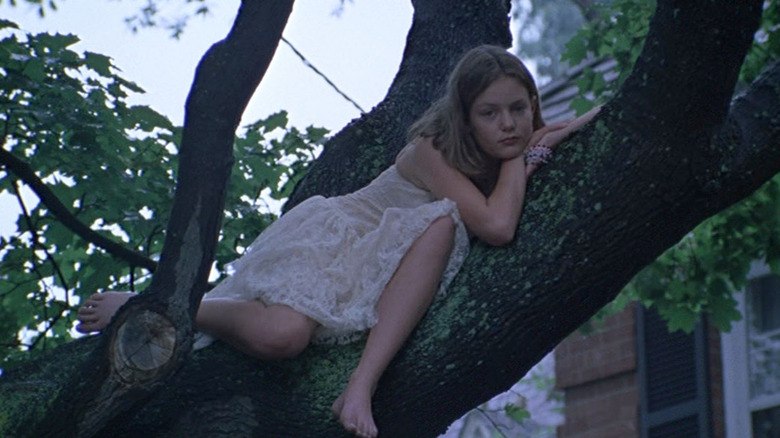The Ending Of The Virgin Suicides Explained
Sofia Coppola's debut feature, "The Virgin Suicides," launched or boosted many a career. Beyond giving Coppola credibility as something other than the worst part of "The Godfather Part 3," the film helped solidify Air as soundtrack scorers par excellence, helped Kirsten Dunst escape childhood stardom, and was an early role for "Criminal Minds" star A.J. Cook.
Based on the novel by Jeffrey Eugenides, "The Virgin Suicides" is about the Lisbon sisters, who all take their lives over the course of one year. Critics of the book felt that it told a complicated story through the Male Gaze in a way that dehumanized the Lisbon sisters. As LitHub puts it, the book is narrated from the Male Gaze itself. Coppola's direction puts us firmly in the dreamy half-imagined world of the sisters. The boys of the neighborhood still narrate the story, but we get a much clearer sense of the sisters' interior lives. Fans return to the film again and again, captivated by Coppola's vision of girlhood.
The beginning of a fruitful partnership
Kirsten Dunst and Sofia Coppola worked together for the first time on "The Virgin Suicides," which began a productive collaboration. Dunst is sometimes framed as Coppola's muse, with the director casting her in two more films and even a photoshoot for W magazine. Coppola helped usher Dunst into the world of adult acting, as Dunst was only 16 when she met the director. "I was a little nervous," Dunst told Variety, explaining why she brought her mother along for the first meeting with Coppola. "It was my first adult role!"
Dunst says that Coppola was a guiding influence on her as she navigated the sexist and looksist landscape of Hollywood. "She said to me, 'I love your teeth; don't ever fix your teeth.' I remember doing a 'Spider-Man' movie later, and one of the producers was like, 'I need to take you to the dentist!' They even fixed my teeth on the poster," she told Variety. "But I just knew I was never doing that. Sofia is the chicest, coolest girl, and she thinks my teeth are great." Dunst and Coppola went on to collab on "Marie Antoinette" and "The Beguiled." Coppola even wrote "Marie Antoinette" with Dunst in mind for the role.
The Virgin Suicides' inspiration and legacy
Critics and fans have long noted the similarities between "The Virgin Suicides" and Peter Weir's 1975 film "Picnic at Hanging Rock." Based on the bestselling Australian novel, Weir's film is a dreamy exploration of the mysterious disappearance of three girls and their teacher. "Picnic at Hanging Rock" gives no resolution to its central mystery, but seems to imply that the disappearance is a natural phenomenon that the colonial power of British Australia is powerless to comprehend. Likewise, the impenetrability of the Lisbon sisters' motivation is central to "The Virgin Suicides." The boys of the neighborhood are forever haunted by the girls, in the same way Michael says he will forever be reminded of the girls' disappearance on the rock.
"The Virgin Suicides" has impacted pop culture, inspiring scads of stories about dead and tragic teen girls. "Veronica Mars" uses the Air soundtrack to connect its murdered teen girl to the Lisbon sisters. Vulture writer Hillary Kelly notes that we can see traces of "The Virgin Suicides" in the cryptic clues and doomed protagonist of "13 Reasons Why" as well as presaging the way nostalgia has taken over pop culture. "It should come as no surprise that three of the biggest franchises of the past 25 years — 'Harry Potter,' 'The Hunger Games,' 'Twilight' — cater to adults imagining themselves back into a sensationalized version of their pasts," she writes.
Symptoms of a larger blight
The Lisbon sisters' suicide is compared to the elm blight that ravages the neighborhood at the same time. Because the Lisbons live in a suburb, all the trees were planted at the same time by the same people. As a result, they are all susceptible to the same blight. The plight of the sisters is framed as a similar consequence of the suburban experience. The constrictive control their mother puts on them goes against the natural development of their social and sexual desires. Their mother wishes to contain them in the same way the Parks Department wants to contain the infected tree in their yard.
The Lisbons' tree infects others in the neighborhood, in much the same way that Cecilia's death infects the Lisbon household and the neighborhood at large. One forum poster linked the trees and the girls' deaths as symbols of inevitable decay. No matter how much landscaping we do, plants die. Humans die. The American suburb is designed to banish thoughts of death and decay, and yet it still encroaches on us all.
If you or anyone you know is having suicidal thoughts, please call the National Suicide Prevention Lifeline at 1-800-273-TALK (8255).



